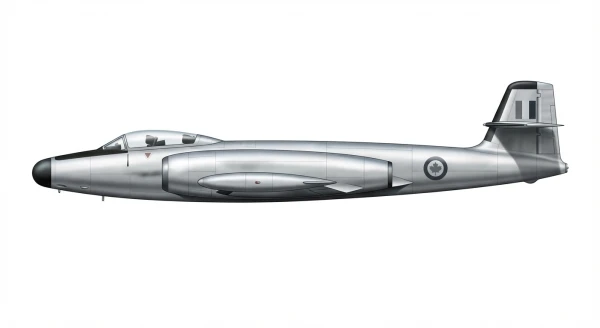CF-100 Canuck
Summary
| Category | Combat Aircraft |
| Origin country | 🇨🇦 Canada |
| Manufacturer | Avro |
| First flight | 19 January 1950 |
| Year introduced | 1953 |
| Number produced | 692 units |
| Average unit price | $1 million |
Description
Work on the CF-100 commenced in October 1946 in response to a Royal Canadian Air Force (RCAF) specification calling for a new jet-powered interceptor/fighter aircraft suitable for long-distance patrol missions and all-weather operations. The formalization of requirements for a two-seat fighter, crewed by a pilot and navigator, centered around the need for powerful engines, an advanced radar set, and a fire control system housed in its nose to enable operations in all-weather or night conditions. Aircraft manufacturer Avro Canada was issued government contracts to commence the associated design work, leading to the XC-100 prototype. Edgar Atkin, Avro Canada's Chief Engineer, initially oversaw the effort, while John Frost served as chief design engineer for military projects.
On 19 January 1950, the CF-100 Mark 1 prototype, 18101, conducted its maiden flight, powered by a pair of Rolls-Royce Avon RA 3 turbojet engines. Both pre-production and production series aircraft were powered by the domestically-developed Avro Orenda engine.
On 18 December 1952, the CF-100 Mk 4 prototype achieved Mach 1.10 in a dive from 14,000 m (45,000 ft), making the type the first straight-winged jet aircraft to achieve controlled supersonic flight.
The CF-100's armament evolved through its production life. The initial Mk 3 variant was equipped with eight .50 caliber Browning M3 machine guns, housing 200 rounds per gun, situated in a forward-firing ventral gun pack, and incorporated the APG-33 radar. The definitive rocket-armed Mk 4A was based on the prototype Mk 4 (a modified Mk 3). The nose housed the much larger APG-40 radar, while later versions, starting with the Mk 4, saw the addition of two wingtip pods, each capable of carrying up to 29 Mk 4/Mk 40 "Mighty Mouse" 70-mm fin-folding aerial rockets, supplementing the existing machine guns. The high-altitude Mk 5 variant featured a longer wingtip and enlarged tailplane, along with removal of the machine guns, relying solely on the rocket armament. A proposed Mk 6 variant was intended to mount Sparrow II missiles.
The CF-100 principally served with the Royal Canadian Air Force and Canadian Armed Forces, with a smaller procurement by Belgium for its air component. Entering service in 1952 during the Cold War, the CF-100 was strategically positioned at NATO bases in Europe and within North America as part of NORAD, contributing to the defense against potential Soviet intrusions. Besides frontline squadrons, the aircraft supported operational training units and secondary roles like aerial reconnaissance and electronic warfare. From 1961, RCAF CF-100s were superseded in the interceptor role by the McDonnell-Douglas CF-101 Voodoo, but some continued in support roles until 1981, ultimately succeeded in training by the Canadair CT-133 Silver Star and in electronic warfare by the CC-117 Falcon.
Main Variants:
-
CF-100 Mk 1: The initial two prototypes of the CF-100, serving as testbeds for the aircraft's design and capabilities.
-
CF-100 Mk 3: The first production version of the Canuck for the RCAF, equipped with eight .50-inch Browning M3 machine guns in a ventral gun pack for offensive capabilities.
-
CF-100 Mk 4: An advanced variant distinguished by its larger APG-40 radar in the nose and wingtip pods housing 29 Mk 4/Mk 40 "Mighty Mouse" folding-fin aerial rockets each, enhancing its all-weather interception capabilities.
-
CF-100 Mk 4B: An improved version of the Mk 4, furnished with more powerful Orenda 11 engines for enhanced performance.
-
CF-100 Mk 5: The final variant in the CF-100 series, featuring extended wingtips, an enlarged tailplane, and the removal of machine guns, optimized for high-altitude interception.
Technical specifications
| Version: CF-100 Mk 5 | |
|---|---|
| Crew | 1 pilot + 1 WSO |
| Operational range | 3,200 km (1,988 mi) |
| Maximum speed | 888 km/h (552 mph) |
| Wing area | 54.9 m² (590.9 sqft) |
| Wingspan | 17.4 m (57.1 ft) |
| Height | 4.4 m (14.4 ft) |
| Length | 16.5 m (54.1 ft) |
| Service ceiling | 13,716 m (45,000 ft) |
| Empty weight | 10,500 kg (23,149 lbs) |
| Max. takeoff weight | 15,170 kg (33,444 lbs) |
| Climb rate | 44.5 m/s (146.0 ft/s) |
| Powerplant | 2 x turbojets Avro Canada Orenda 11 delivering 3311 kgf each |
| Ejection seat | Martin-Baker Mk 2 |
Current operating countries

